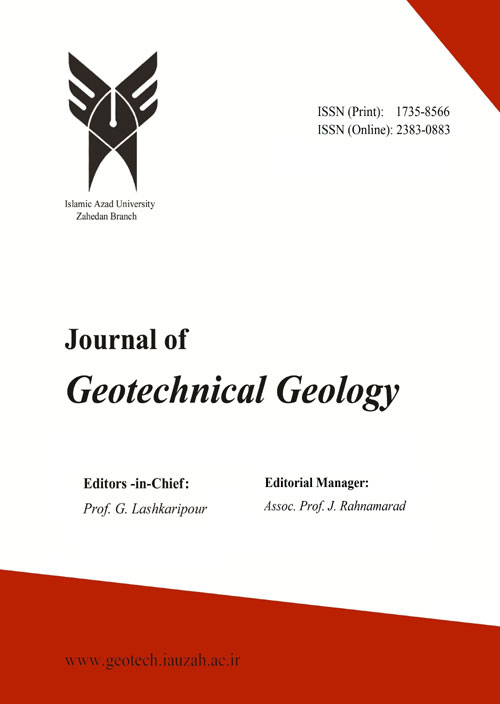فهرست مطالب
Journal of Geotechnical Geology
Volume:15 Issue: 2, Summer and Autumn 2019
- تاریخ انتشار: 1398/09/10
- تعداد عناوین: 5
-
Pages 289-296Decision-making in energy planning must take into account several aspects due to the increasing complexity of social, technological and economic factors. Analytical Hierarchy Process (AHP) is a multi criterion decision making technique and gin that, the problems are decomposed into a hierarchically structure and are given the weights according to its importance. The output is a priority ranking indicating the overall preference for each decision alternative. This paper describes the application of AHP to select a geothermal prospect in Iran country to be developed in the future. Three major criteria are used and applied into those three prospects: geosciences, infrastructure, and social-culture aspects. The benefits of using AHP are (1) the facts and reasons behind the decision are well documented, (2) able to handle quantitative and qualitative inputs, and (3) able to accommodate environmental and social aspect. Based on the participation of experts, 3 criteria and 20 sub criteria were defined. The results showed that the most relevant criteria were the geology 68.3%, technical 18.8% and social economic 12.9%.Keywords: Geothermal Energy, Hierarchical decision making, Geothermal reserves, Iran
-
Pages 297-302Clayey minerals are considered as the most important factor causing soils swelling, especially fine-grained soils. This phenomenon also causes the destruction of soil structure and texture and in the water vicinity makes damage to surrounding structures. Therefore, identifying and improving the condition of such soils can be very useful. For this purpose, standard laboratory methods have been proposed to evaluate the swelling potential of clayey soils. In this study attempted to use these laboratory methods to evaluate the clayey soils’ physicochemical characteristics and swelling potential form Ajabshir, East-azerbaijan province, NW of Iran. In this regard, the field survey, sampling and laboratory tests (such as physical, chemical and mechanical) conducted on 30 specimens were taken in Ajabshir. The soils samples are classified by United States Department of Agriculture (USDA) classification to identify the clay minerals classes for Ajabshir’s soil. Also, the indirect swelling potential evaluation was applied for providing the swellability condition of the studied soils.Keywords: Clay Minerals, Swelling potential, Clay soils, physicochemical characteristics, Ajabshir
-
Pages 303-311
Phenomena of land subsidence, increasing the effective stress (σ1) of the body of aquifer sediments have not consolidated. Because the weight of the upper overburden aquifer sediments by the solid and the fluid contained in the pore space to be tolerated when the fluid pressure caused by drop in the water table the decrease in the effective stress increased this results in soil compaction and evidence of subsidence in the area, Such as tensile cracks, crack growth in civil structures tube wells in plain. The last few years Bagstrsh, Land subsidence caused major problems for the agriculture and can be civil structures near these gaps. In line with the international studies in this research area as a pilot scheme studied Khorramabad. In general it can be stated that decline in groundwater levels in Khorramabad plain area, increasing the effective stress in the alluvial plain water depths ranging from plain and prevent to avoid potential supply normal rainfall factors accretion phenomena Khorramabad plain island subsidence. Near the underground water, Thickness of clay and fine materials, the presence of active faults Khorramabad anticline and humanitarian intervention mechanisms developed in this area, because increased incidence of subsidence phenomenon in the area that will be output by the model is consistent with the content.
Keywords: Land subsidence, Effective stress, Pore-pressure, Khorramabad Plain, Groundwater levels -
Pages 319-326Road construction projects are considered as the largest infrastructure projects in Countries, which always face the most problems in construction. The longitudinal extent of the projects has caused them to cross different geological conditions and be under different climatic conditions which involvement of various factors in operation of road construction has caused time delays. In this regard, the present study has tried to consider the relationship between factors affecting the project construction and time delay of Tabriz-Bonab road project. For this purpose, the multi-criteria hierarchical analysis (AHP-MCDM) method has been used to prioritize and measure the effective factors in the project. Based on the evaluations, 6 main factors including human, environmental, managerial, technical, infrastructure and technical errors were involved in the project, each of them can be divided into several sub-factors which managerial as well as infrastructure factors have the greatest impact on the project delay and environmental factors have the least impact on the project.Keywords: Engineering project management, analytic hierarchy process, Multiplecriteria decision analysis, Delay-time assessment, Highway Project
-
Pages 327-330The presented article tried to utilize the empirical rock mass classifications to rock mass quantification and stability analysis for several open-pit mining projects in Khoy, West-Azerbaijan, NW of Iran. For this purpose, the geomechanical classifications including rock mass rating (RMR), slope mass rating (SMR), and Qslope have been used. The study aim is provide the quick assessment by considering these classifications to appropriate mines design and stability analysis which implemented on 20 open-pit mining cases in Khoy. Based on the results, it has been determined that most slopes are in the generally stable class, but some of the slopes show unstable conditions which stabilization is necessary. In the meantime, one slope is in an unfavorable condition.Keywords: Engineering Geology, Empirical classification, Slope Stability, Open-pit mining, Khoy


